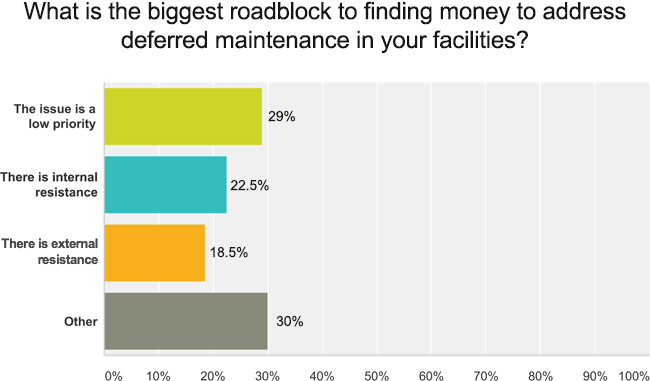Deferred Maintenance: Addressing the Problemtest
By Dave Lubach, Associate Editor
June 2015
One possibly encouraging sign from the survey results is that many of the respondents estimated their deferred maintenance totals below $5 million, Harvey says.
“Maybe it shows that people are taking better care of their buildings,” he says. “There are some codes and guidelines coming out that are going to be mandated, and with the energy code having a big impact, (regulations) will become more and more strict over the years. To hit those energy metrics, (managers) will have to keep their buildings running smoother, so it’s a good thing for everyone to reduce operating costs and spend the money where it’s more useful.”
For managers hoping to make progress on deferred maintenance, Harvey offers these suggestions:
First, establish a strong preventive maintenance plan.
“If managers are not comfortable communicating what the deferred maintenance items are and what the preventive maintenance budget needs to be, I think they should probably seek outside help from different vendors or architects or consulting engineers and put a little more expertise on the subject matter and say, ‘Here’s what our engineer thinks needs to happen next year’,” Harvey says.
Second, get involved in projects as early as possible.
“I would be the squeaky wheel and ask to be involved, even if it’s nothing more than reviewing drawings or being present at construction or looking at maintenance items,” he says. “I would highly encourage doing that and helping drive the project, whether it’s product selection or system-type selection, to get what you want in there and make the long-term maintenance of the systems easier and more consistent.”

Finally, to keep deferred maintenance in check, managers should consider projects that offer longer returns on investment, Harvey says.
“You have to look at (projects) on an item-by-item basis and see what your deferred maintenance expenditures are going toward,” he says. “A lot of those things can have a return on investment and not have the criteria the CFO is looking for. A lot of CFOs are looking for three-four year paybacks on things, which a lot of deferred maintenance can’t do, but it may have a seven-eight year payback.
“It’s hard to put a dollars-per-square-foot on deferred maintenance items because year after year after year, it just gets kind of exponential on you. The longer you let it go, the worse the repairs can be, and the more expensive they’re going to be to take care of, especially if there’s a catastrophic failure.”
